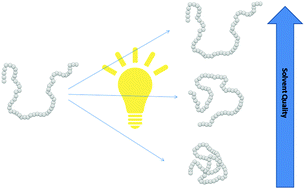The importance of solvent quality on the modification of conjugated polymer conformation and thermodynamics with illumination†
Abstract
Device efficiency in key organic electronic devices such as organic photovoltaics, field transistors, and light emitting diodes has long been known to be closely tied to the conformation of the conjugated polymer chains which make up the active layers. Our previous results show that light exposure can have a profound effect on the structure and assembly of these optoelectronic materials in solution. In order to advance our understanding of the role which solvent quality plays in this phenomenon, we have further studied the modulation of these illumination dependent structural changes on the key benchmark conjugated polymers P3HT and MEH-PPV as a function of solvent quality over a wide range of polymer solubilities. Analysis of this data indicates that use of poorer conjugated polymer solvents ultimately results in larger absolute alterations to polymer conformation, denoting the crucial role which solution thermodynamics plays in this generic effect. This discovery opens the door to controlling final device morphology through careful manipulation of solvent composition during solution based device casting techniques, moving our efforts closer to the development of a powerful, non-destructive, and tunable method for light-driven control of polymer conformation in novel light-responsive organic materials.



 Please wait while we load your content...
Please wait while we load your content...